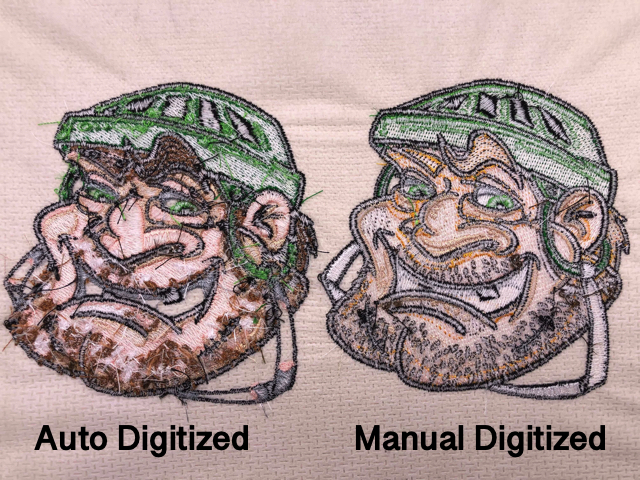Premier Digitizing for Embroidery: Perfect Stitch Whenever
Wiki Article
Simplifying the Art of Needlework Digitizing: Step-by-Step Overview
As modern technology continues to advance, the digitization process has actually come to be much more available, enabling lovers to bring their intricate layouts to life with ease. In this overview, we will unwind the intricacies of needlework digitizing, damaging down each step methodically to improve the process and empower both newbies and seasoned embroiderers alike.Understanding Needlework Digitizing Software
Needlework digitizing software program functions as a critical tool for changing elaborate styles into electronic layouts compatible with needlework equipments, helping with accurate sewing and customization. This specialized software enables individuals to import different image data formats, such as JPG or PNG, and convert them into needlework machine-readable formats like DST, EXP, or PES - Digitizing for Embroidery. By making use of features like stitch editing, rug choices, and thread color choice, digitizing software program enables customers to manage every facet of the layout processFurthermore, advanced embroidery digitizing software application provides tools for creating complicated layouts, changing stitch density, and including intricate details. Customers can likewise preview the layout prior to sewing it out, guaranteeing precision and minimizing errors. In addition, lots of software programs offer automated functions that aid simplify the digitizing process, conserving time and initiative.
Comprehending the capabilities of embroidery digitizing software is important for attaining top quality cause embroidery jobs. By mastering this tool, embroidery fanatics and experts can release their creativity and bring intricate styles to life with precision and effectiveness.

Selecting the Right Style File
After acquainting on your own with the abilities of embroidery digitizing software program, the next critical step in the procedure is selecting the best layout apply for your task. Digitizing for Embroidery. When choosing a style apply for needlework digitizing, it's vital to take into consideration the intricacy of the style, the dimension of the end product, and the sort of material you will be dealing withFor detailed layouts with fine details, a high-resolution photo or vector file is suggested to ensure that the needlework device can precisely reproduce the design. Furthermore, the size of the end product plays a substantial duty in choosing the appropriate layout data. Larger styles may require higher resolution files to maintain quality and sharpness.
In addition, the type of material you will be embroidering on influences the selection of style documents. Different fabrics might need adjustments in the layout file to ensure that the stitches are effectively aligned and the style looks like planned. By very carefully choosing the appropriate style data based on these factors, you can establish on your own up for a why not try these out successful needlework digitizing process.
Digitizing Devices and Methods
Using specialized software program and accuracy techniques, digitizing tools are crucial in transforming detailed layouts right into embroidery-ready documents. Embroidery digitizing software, such as Wilcom, Hatch, or Embrilliance, offers the required platform to convert art work right into stitch data. These programs provide features like stitch modifying, underlay choices, and lettering tools to ensure the layout converts effortlessly onto textile.Among the essential strategies in digitizing is creating a clear course for the embroidery device to comply with. This entails digitizing each component of the layout with accuracy, establishing stitch types, thickness, and directions. By utilizing tools like digitizing tablet computers or software-specific plugins, embroiderers can accomplish a high degree of accuracy in their digitized styles.
Moreover, mastering the art of padding stitching is crucial for producing quality embroidery. Underlay sewing stabilizes the fabric and produces a structure for the style, making sure that the end product is both aesthetically appealing and lasting. By recognizing these digitizing devices and techniques, embroiderers can boost their craft and bring intricate styles to life with precision and efficiency.
Personalizing Stitch Kinds and Instructions
Having actually established a foundation in digitizing tools and methods, a crucial element ahead of time needlework craftsmanship lies in customizing stitch types and instructions with accuracy and objective. The choice of stitch kinds can considerably influence the general look dig this and texture of the stitched design. Satin stitches, understood for their smooth and shiny finish, job well for developing boundaries and message. On the various other hand, fill stitches are excellent for covering bigger locations effectively. By purposefully incorporating these stitch types, embroiderers can achieve depth and dimension in their discover this layouts.Moreover, the instructions of stitches plays a critical function in boosting the aesthetic charm of the final needlework. By exploring with various stitch angles and patterns, embroiderers can bring their layouts to life with exceptional information and complexity.
Screening and Refining Your Digitized Style
To make sure the accuracy and high quality of your digitized design, extensive screening and improvement are essential actions in the needlework digitizing process. Once you have completed the digitization of your layout, it is vital to check it prior to waging the real embroidery. Evaluating permits you to determine any kind of potential concerns such as string breaks, sew density issues, or layout distortions that might impact the outcome.
After screening, it is very important to fine-tune your digitized style based on the comments from the test sew-out. This might involve tweaking stitch setups, readjusting thickness, or making modifications to the overall design to accomplish the preferred end result. By repeating with testing and improvement, you can tweak your digitized layout to perfection prior to relocating ahead with the real embroidery process.
Conclusion
To conclude, mastering the art of needlework digitizing calls for a detailed understanding of the software, picking the best style file, making use of digitizing tools and methods, personalizing stitch types and directions, and testing and fine-tuning the digitized design. By following these steps, embroiderers can simplify the digitizing procedure and develop top notch embroidered styles with precision and performance.Report this wiki page